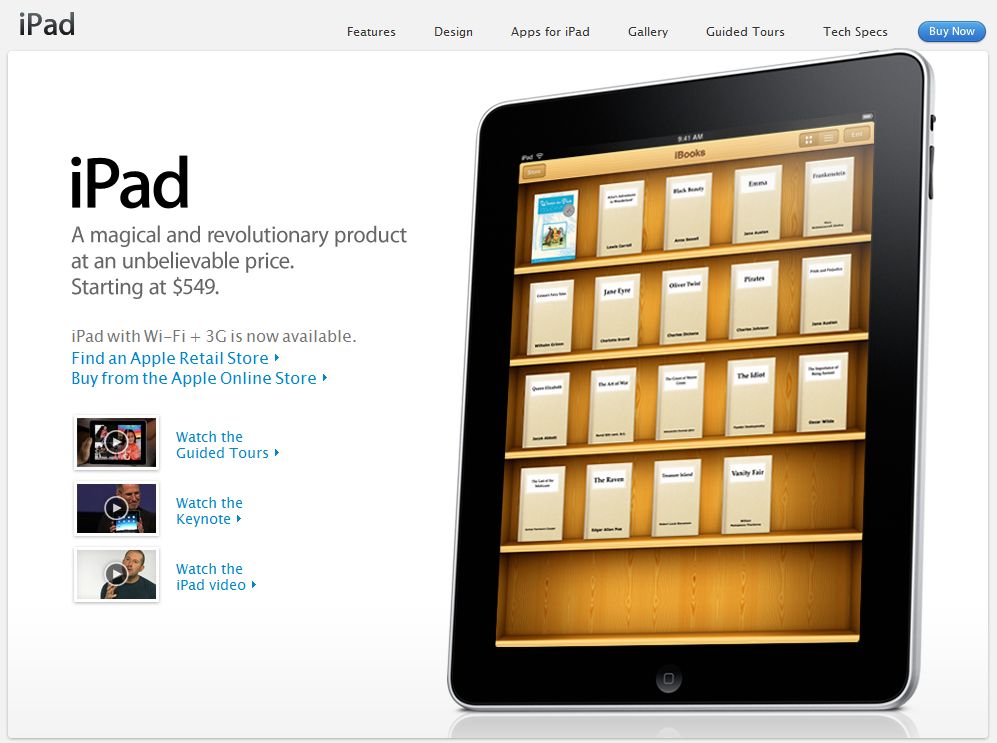I say this as someone who has owned an iPad Pro since 2017.
When the iPad debuted in 2010, Steve Jobs pitched it as a “between” device that could do things a smartphone could, and things a desktop computer could–but it could do them in a more convenient form. The activities included:
- Browsing web pages
- Reading magazines and books
- Watching video
All of these activities require minimal interaction, so they are suited to a touch-oriented device. The iPad’s larger display–yet still eminently portable design–makes it superior to a smartphone for viewing web pages or magazines, though with more responsive designs and larger phone screens, this use case is not quite as compelling as it once was. It’s still better for watching video in bed than a laptop or phone, I’d say.
Jobs only lived long enough to see one iteration of the iPad, called, cleverly1Given Apple’s often byzantine and arbitrary naming schemes, this is not sarcasm!, the iPad 2. It refined what was in the original, but otherwise changed nothing. It was just a better iPad.
That changed a bit in 2012 when Apple introduced the iPad Mini. It was, quite literally, a smaller version of the iPad. This didn’t change much, but it did mean that consumers now had two distinct choices when buying an iPad: regular size or smaller.
Apple then blew things up when they introduced the original iPad Pro in 2015. This had some refinements, but mostly it was bigger, going from a 9.7″ display to a 12.9″ one. Apple muddied the waters by later introducing a 9.7″ iPad Pro, which really wasn’t much better than the standard iPad Air available at the time (also a 9.7″ device). Apple “fixed” this by junking the Air (for a while) and bringing in a new base model iPad that stripped away things like the laminated display, but also dropped the price to a mere $299 (the original iPad sold for $499). The Pro models also supported a stylus, the Apple Pencil.
Does anything in the above paragraph look like a carefully-planned, long term strategy? Because it is not. It is Apple deciding one thing (“We need an upscale iPad so we can charge a premium price”) and then shuffling everything else around to make the line-up work. The early iPad Pros, apart from supporting Apple Pencil–an arbitrary limitation that was lifted a few years later, when Pencil support was added to all the myriad iPad models–didn’t really do anything that the base model couldn’t do. They looked a bit nicer, they sounded a bit better, they ran faster (not that you could really notice).
It was the Apple Pencil support that got me to buy that 10.5″ iPad Pro in 2017, then to move to the 12.9″ model when it was new in 2020 (I still use it today). It seemed like a way to get a Cintiq-like device, but (surprisingly, given Apple) for less than an actual Cintiq would cost. (This year’s iPad Pro models have reversed that, as Apple leaned much more into making the Pro model “premium”–even though it still can’t do anything more than a $300 iPad you can grab at your local Walmart.)
When I bought the 12.9″ iPad Pro in 2020, I got it from Apple directly and paid $1167. That’s pricey! The equivalent 2024 version is $1799. That’s silly.
But the price is not the main reason the iPad Pro is silly. You were probably wondering when I was going to get to this.
The silly part is: No one needs an iPad Pro. I don’t, you don’t, Apple doesn’t. Apple started the line to generate more revenue, and now they’ve jacked prices because Apple is in one of its greed-driven, “squeeze them for everything” phases (the last time was in the mid-90s). But in the drive for more money, Apple has boxed itself in, adding bits and pieces to iPadOS (which, let’s be serious, is just iOS with a different sticker on it), trying to make it work more like a laptop, with split screen, Stage Manager, a Files app (which started terrible and has stayed terrible since its introduction). But it is still marred by terrible memory management, arbitrary restrictions, a lack of utilities, and turning one or two click operations on a PC into a maze of steps, swipes and taps that sometimes just fail at the end, forcing you to start over.
It’s a mess and it’s a mess because Apple made a fundamental error in 2015 by introducing the iPad Pro. They got greedy, they made a mess, and in almost 10 years have failed to clean it up. WWDC 2024 is tomorrow, and Apple will probably make a few more token gestures to fixing iPadOS. But I don’t think they can.
The basic iPad experience is fine. Apple should refine what is there now to work better.
But here’s my advice for a company regularly valued at $2-3 trillion:
- Keep the base iPad, Air and Mini. Lose the suffixes. They are all iPads now, differentiated only by size. If they insist on a cost-cutting base model, call it the iPad SE.
- Kill the iPad Pro. Yep, kill it! No more iPad Pros! Continue to support existing models for 5–7 years.
- Introduce a Mac tablet that runs a touch version of macOS. Include optional support to run a virtualized iPadOS.
Now you have a truly professional-calibre touch device. Yes, I’m basically asking Apple to re-invent the Surface Pro, but with Apple’s level of polish and precision.
The iPad Pro is just not going to get better, software-wise, without major surgery on the operating system that Apple will never commit to. So they shouldn’t. They should just give up and put out touch-based Macs instead.
Because the iPad Pro is silly.



